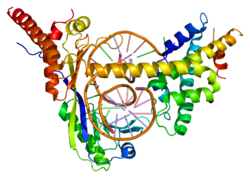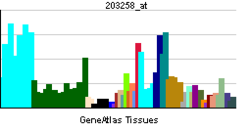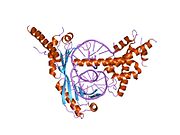- DRAP1
-
DR1-associated protein 1 (negative cofactor 2 alpha) 
PDB rendering based on 1jfi.Available structures PDB 1jfi Identifiers Symbols DRAP1; NC2-alpha External IDs OMIM: 602289 MGI: 1913806 HomoloGene: 4703 GeneCards: DRAP1 Gene Gene Ontology Molecular function • DNA binding
• sequence-specific DNA binding transcription factor activity
• transcription corepressor activity
• transcription factor binding
• sequence-specific DNA bindingCellular component • intracellular
• nucleusBiological process • negative regulation of transcription from RNA polymerase II promoter
• transcription, DNA-dependentSources: Amigo / QuickGO RNA expression pattern 
More reference expression data Orthologs Species Human Mouse Entrez 10589 66556 Ensembl ENSG00000175550 ENSMUSG00000024914 UniProt Q14919 Q4FJW2 RefSeq (mRNA) NM_006442 NM_024176.1 RefSeq (protein) NP_006433 NP_077138.1 Location (UCSC) Chr 11:
65.69 – 65.69 MbChr 19:
5.42 – 5.42 MbPubMed search [1] [2] Dr1-associated corepressor is a protein that in humans is encoded by the DRAP1 gene.[1][2]
Transcriptional repression is a general mechanism for regulating transcriptional initiation in organisms ranging from yeast to humans. Accurate initiation of transcription from eukaryotic protein-encoding genes requires the assembly of a large multiprotein complex consisting of RNA polymerase II and general transcription factors such as TFIIA, TFIIB, and TFIID. DR1 is a repressor that interacts with the TATA-binding protein (TBP) of TFIID and prevents the formation of an active transcription complex by precluding the entry of TFIIA and/or TFIIB into the preinitiation complex. The protein encoded by this gene is a corepressor of transcription that interacts with DR1 to enhance DR1-mediated repression. The interaction between this corepressor and DR1 is required for corepressor function and appears to stabilize the TBP-DR1-DNA complex.[2]
Interactions
DRAP1 has been shown to interact with FOXH1[3] and DR1.[1][4]
References
- ^ a b Mermelstein F, Yeung K, Cao J, Inostroza JA, Erdjument-Bromage H, Eagelson K, Landsman D, Levitt P, Tempst P, Reinberg D (May 1996). "Requirement of a corepressor for Dr1-mediated repression of transcription". Genes Dev 10 (8): 1033–48. doi:10.1101/gad.10.8.1033. PMID 8608938.
- ^ a b "Entrez Gene: DRAP1 DR1-associated protein 1 (negative cofactor 2 alpha)". http://www.ncbi.nlm.nih.gov/sites/entrez?Db=gene&Cmd=ShowDetailView&TermToSearch=10589.
- ^ Iratni, Rabah; Yan Yu-Ting, Chen Canhe, Ding Jixiang, Zhang Yi, Price Sandy M, Reinberg Danny, Shen Michael M (Dec. 2002). "Inhibition of excess nodal signaling during mouse gastrulation by the transcriptional corepressor DRAP1". Science (United States) 298 (5600): 1996–9. doi:10.1126/science.1073405. PMID 12471260.
- ^ Yeung, K; Kim S, Reinberg D (Jan. 1997). "Functional dissection of a human Dr1-DRAP1 repressor complex". Mol. Cell. Biol. (UNITED STATES) 17 (1): 36–45. ISSN 0270-7306. PMC 231727. PMID 8972183. http://www.pubmedcentral.nih.gov/articlerender.fcgi?tool=pmcentrez&artid=231727.
Further reading
- Goppelt A, Stelzer G, Lottspeich F, Meisterernst M (1996). "A mechanism for repression of class II gene transcription through specific binding of NC2 to TBP-promoter complexes via heterodimeric histone fold domains.". EMBO J. 15 (12): 3105–16. PMC 450253. PMID 8670811. http://www.pubmedcentral.nih.gov/articlerender.fcgi?tool=pmcentrez&artid=450253.
- Yeung K, Kim S, Reinberg D (1997). "Functional dissection of a human Dr1-DRAP1 repressor complex.". Mol. Cell. Biol. 17 (1): 36–45. PMC 231727. PMID 8972183. http://www.pubmedcentral.nih.gov/articlerender.fcgi?tool=pmcentrez&artid=231727.
- Ikeda K, Halle JP, Stelzer G, et al. (1998). "Involvement of negative cofactor NC2 in active repression by zinc finger-homeodomain transcription factor AREB6.". Mol. Cell. Biol. 18 (1): 10–8. PMC 121442. PMID 9418848. http://www.pubmedcentral.nih.gov/articlerender.fcgi?tool=pmcentrez&artid=121442.
- Castaño E, Gross P, Wang Z, et al. (2000). "The C-terminal domain-phosphorylated IIO form of RNA polymerase II is associated with the transcription repressor NC2 (Dr1/DRAP1) and is required for transcription activation in human nuclear extracts.". Proc. Natl. Acad. Sci. U.S.A. 97 (13): 7184–9. doi:10.1073/pnas.140202297. PMC 16520. PMID 10852970. http://www.pubmedcentral.nih.gov/articlerender.fcgi?tool=pmcentrez&artid=16520.
- Kamada K, Shu F, Chen H, et al. (2001). "Crystal structure of negative cofactor 2 recognizing the TBP-DNA transcription complex.". Cell 106 (1): 71–81. doi:10.1016/S0092-8674(01)00417-2. PMID 11461703.
- Iratni R, Yan YT, Chen C, et al. (2003). "Inhibition of excess nodal signaling during mouse gastrulation by the transcriptional corepressor DRAP1.". Science 298 (5600): 1996–9. doi:10.1126/science.1073405. PMID 12471260.
- Denko N, Wernke-Dollries K, Johnson AB, et al. (2003). "Hypoxia actively represses transcription by inducing negative cofactor 2 (Dr1/DrAP1) and blocking preinitiation complex assembly.". J. Biol. Chem. 278 (8): 5744–9. doi:10.1074/jbc.M212534200. PMID 12477712.
- Strausberg RL, Feingold EA, Grouse LH, et al. (2003). "Generation and initial analysis of more than 15,000 full-length human and mouse cDNA sequences.". Proc. Natl. Acad. Sci. U.S.A. 99 (26): 16899–903. doi:10.1073/pnas.242603899. PMC 139241. PMID 12477932. http://www.pubmedcentral.nih.gov/articlerender.fcgi?tool=pmcentrez&artid=139241.
- Leonard D, Ajuh P, Lamond AI, Legerski RJ (2003). "hLodestar/HuF2 interacts with CDC5L and is involved in pre-mRNA splicing.". Biochem. Biophys. Res. Commun. 308 (4): 793–801. doi:10.1016/S0006-291X(03)01486-4. PMID 12927788.
- Gerhard DS, Wagner L, Feingold EA, et al. (2004). "The status, quality, and expansion of the NIH full-length cDNA project: the Mammalian Gene Collection (MGC).". Genome Res. 14 (10B): 2121–7. doi:10.1101/gr.2596504. PMC 528928. PMID 15489334. http://www.pubmedcentral.nih.gov/articlerender.fcgi?tool=pmcentrez&artid=528928.
- Klejman MP, Pereira LA, van Zeeburg HJ, et al. (2004). "NC2alpha interacts with BTAF1 and stimulates its ATP-dependent association with TATA-binding protein.". Mol. Cell. Biol. 24 (22): 10072–82. doi:10.1128/MCB.24.22.10072-10082.2004. PMC 525489. PMID 15509807. http://www.pubmedcentral.nih.gov/articlerender.fcgi?tool=pmcentrez&artid=525489.
- Lewis BA, Sims RJ, Lane WS, Reinberg D (2005). "Functional characterization of core promoter elements: DPE-specific transcription requires the protein kinase CK2 and the PC4 coactivator.". Mol. Cell 18 (4): 471–81. doi:10.1016/j.molcel.2005.04.005. PMID 15893730.
- Stelzl U, Worm U, Lalowski M, et al. (2005). "A human protein-protein interaction network: a resource for annotating the proteome.". Cell 122 (6): 957–68. doi:10.1016/j.cell.2005.08.029. PMID 16169070.
- Rual JF, Venkatesan K, Hao T, et al. (2005). "Towards a proteome-scale map of the human protein-protein interaction network.". Nature 437 (7062): 1173–8. doi:10.1038/nature04209. PMID 16189514.
- Assmann EM, Alborghetti MR, Camargo ME, Kobarg J (2006). "FEZ1 dimerization and interaction with transcription regulatory proteins involves its coiled-coil region.". J. Biol. Chem. 281 (15): 9869–81. doi:10.1074/jbc.M513280200. PMID 16484223.
- Lim J, Hao T, Shaw C, et al. (2006). "A protein-protein interaction network for human inherited ataxias and disorders of Purkinje cell degeneration.". Cell 125 (4): 801–14. doi:10.1016/j.cell.2006.03.032. PMID 16713569.
- Albert TK, Grote K, Boeing S, et al. (2007). "Global distribution of negative cofactor 2 subunit-alpha on human promoters.". Proc. Natl. Acad. Sci. U.S.A. 104 (24): 10000–5. doi:10.1073/pnas.0703490104. PMC 1891239. PMID 17548813. http://www.pubmedcentral.nih.gov/articlerender.fcgi?tool=pmcentrez&artid=1891239.
PDB gallery Categories:- Human proteins
- Chromosome 11 gene stubs
Wikimedia Foundation. 2010.

